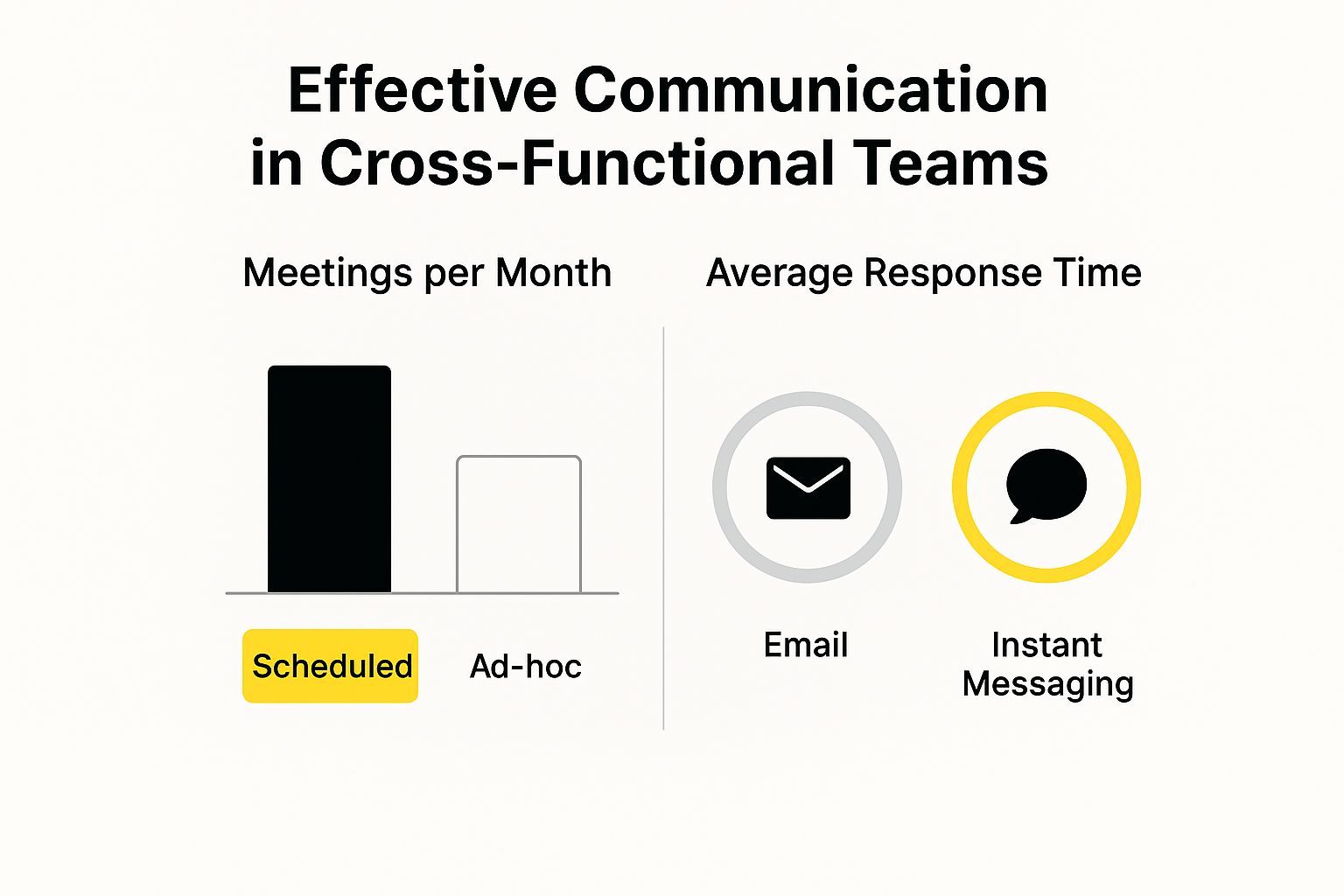Managing a cross-functional team is less about just hitting project goals and more about mastering the human dynamics at play. It’s about building a solid structure where a diverse group of experts can actually work together productively, cutting through the natural friction that comes with their different backgrounds. This means you have to establish clear roles, a shared purpose, and open lines of communication right from the start.
The Real Challenge of Cross-Functional Teamwork
On paper, the idea of a cross-functional team is a no-brainer. You bring together your best talent—an engineer, a marketer, a designer, a data analyst—to solve a complex problem. You expect a tidal wave of innovation and speed, with all that expertise blending into something brilliant.
But the reality? It’s often a mess.
These teams are frequently set up to fail before the first kickoff meeting even happens. The problem isn’t a lack of talent; it’s a clash of entire worlds. Each person walks in with their own departmental jargon, priorities, and definition of success. The marketer is chasing leads, the engineer is focused on code stability, and the finance person is guarding the budget. Without a single, unifying framework, these competing goals create immediate—and often invisible—friction.
Why Do These Teams Struggle?
The disconnect is deeper than just departmental goals. It comes from fundamental differences in how people are trained to work and what they’re rewarded for. An engineer’s “done” means the feature is built and tested. For the marketing team, “done” means it’s live, promoted, and driving traffic. It seems like a small difference in wording, but that gap can lead to huge misalignments and project delays.
The hard truth is that just throwing talented people into a room together isn’t enough. You have to intentionally dismantle the silos they come from, and that’s a massive management challenge.
This is exactly why so many of these initiatives fall short. In fact, a landmark Harvard Business Review survey revealed that a staggering 75% of cross-functional teams were dysfunctional in at least three of five key areas, like staying on budget, meeting schedules, and aligning with company goals. While management has evolved since then, this historical data underscores how tough this is. Coordination breakdowns and conflicting objectives are just part of the territory. For more on these dynamics, check out the insights from Vantage Circle.
Common Dysfunctions and Their Root Causes
Before you can fix these issues, you have to understand what causes them. The problems that sink cross-functional teams aren’t random; they follow predictable patterns. Fuzzy lines of authority create power vacuums. Unclear communication protocols breed confusion. A lack of shared purpose means everyone is pulling in a different direction.
To get ahead of this, I’ve seen it’s critical to identify the most common areas of dysfunction and trace them back to their root causes. This isn’t about blaming individuals; it’s about seeing the systemic issues that set them up for failure.
Here’s a breakdown of the five major areas where dysfunction appears, along with the most common underlying reasons I’ve encountered.
| Area of Dysfunction | Common Root Cause | Initial Step to Address |
|---|---|---|
| Staying on Budget | Incomplete initial scoping; not all functional requirements were gathered upfront. | Implement a Functional Scoping Workshop before any budget is finalized. |
| Meeting the Schedule | Dependencies between different functional tasks were never clearly mapped out. | Create a Shared Dependency Map that visually connects all work streams. |
| Meeting Customer Needs | The team lacks a unified, direct connection to the end user. | Establish a Unified Customer Persona that all departments agree on and use. |
| Adhering to Specifications | Each department interprets “specifications” through its own technical lens. | Develop a “Plain Language” Spec Sheet that translates technical details for all. |
| Aligning with Company Goals | The team’s project-level goals don’t clearly connect to the larger business strategy. | Start every project with a “Goal-to-Strategy” Session linking the project to company KPIs. |
Recognizing these issues not as individual failures but as predictable hurdles is the first real step. When you anticipate this friction, you can start building the structures and processes needed to guide the team away from chaos and toward genuine, successful collaboration.
A high-performing cross-functional team doesn’t just happen by accident. It’s carefully engineered with intention, long before the first major deadline ever looms. If you want to avoid the friction and misalignment that can completely derail projects, building this foundation is your best defense. This means moving beyond simple icebreakers and getting serious about creating a solid operational blueprint.

This proactive approach is gaining real traction. It’s not just a nice-to-have anymore. Top industries are boosting their budgets for team building specifically to improve how these mixed teams perform. In fact, by 2025, 90% of tech leaders planned to increase their engagement budgets. We’ve also seen finance firms that ran monthly team-building exercises see a 15% jump in project success rates. The data is clear: investing in team cohesion pays off.
Establish a Compelling Shared Purpose
The first pillar of a strong foundation is a shared purpose. This isn’t just about the project goal; it’s the “why” that truly unites everyone. When you bring people together from marketing, engineering, and finance, they all walk in with different departmental objectives and KPIs. Your job is to craft a single, compelling narrative that rises above those individual goals.
For example, don’t just say, “Our goal is to launch the new feature.” That’s a task. Instead, frame it as a mission: “Our mission is to slash customer support tickets by 30% by creating a more intuitive user experience.” See the difference? The focus shifts from departmental outputs to a collective outcome everyone can get behind. This shared mission becomes the North Star for every single decision.
I once managed a mobile app project where the developers were obsessed with features, while the finance expert was laser-focused on ROI. Their priorities were miles apart. We sat down and reframed our purpose from “building an app” to “helping busy parents save 15 minutes a day.” That simple change instantly aligned their work. Every feature idea and budget request was suddenly much easier to evaluate against that common goal.
Define Roles and Responsibilities with a RACI Matrix
Ambiguity is the absolute enemy of cross-functional success. When roles are vague, you either get duplicated work or, even worse, critical tasks fall through the cracks. The most effective tool I’ve found to prevent this chaos is co-creating a RACI matrix right in the kickoff meeting.
A RACI chart makes it crystal clear who is:
- Responsible: The person (or people) actually doing the work.
- Accountable: The one individual who owns the final decision and outcome. Critically, there should only be one “A” per task.
- Consulted: The subject matter experts who need to provide input and feedback before work is done.
- Informed: The stakeholders who just need to be kept in the loop on progress.
This simple exercise forces the tough conversations to happen early. It makes everyone explicitly agree on who owns what, heading off future power struggles or confusion before they can start. For more on setting up strong management frameworks, especially for varied teams, you might find these proven strategies for remote workforce management helpful.
Co-Create a Team Charter
Think of your team charter as your team’s constitution. It’s a living document created by the team, for the team, that outlines exactly how you’ll all work together. This goes way beyond the project scope—it governs your internal dynamics and sets clear expectations for behavior.
A team charter isn’t a formality you create and file away. It’s a living reference point for navigating conflict and making tough decisions. When disagreements pop up, you can literally point to the charter and ask, “What did we agree to?”
Your charter should define a few key areas:
- Communication Norms: How will you talk to each other? When is Slack okay, and when does a topic demand a formal meeting? What are the expected response times?
- Decision-Making Framework: How will decisions be made? Is it by consensus? Does the “Accountable” person get the final say after consultation? What’s the process for breaking a tie?
- Conflict Resolution Protocol: When disagreements inevitably happen, what’s the process for resolving them? It’s far better to define an escalation path before you actually need one.
- Meeting Cadence and Structure: How often will you meet? What’s the purpose and format of each gathering (e.g., daily stand-ups, weekly syncs, monthly reviews)?
Developing a solid communication plan is a huge piece of this puzzle. To help get this down on paper, you might want to check out our guide on creating a stakeholder communication plan, which offers a structured approach you can easily adapt for your team charter. By proactively building this foundation, you turn a group of individual experts into a truly cohesive, high-performing unit ready for any challenge.
Creating a Culture of Open Communication
Let’s be honest: you can buy all the right software, but if your team doesn’t feel safe speaking up, you’ve got nothing. Effective communication in a cross-functional team starts with building a culture of psychological safety. It’s the bedrock that allows people to float ideas, flag concerns, and even admit they messed up without fearing blame.
Without this safety net, the rich diversity of your team—all those different perspectives from engineering, marketing, design, and sales—becomes a source of friction instead of your greatest strength.

What you’re really aiming for is an environment that transforms a group of individual specialists into one cohesive unit. It’s about creating a space where an engineer feels perfectly comfortable questioning a marketing assumption, or a designer can push back on a technical limitation. This is where real innovation happens.
Setting Clear Communication Expectations
First things first: you have to get rid of the ambiguity around how the team talks to each other. Don’t just hope for the best. Your team charter needs to spell out the communication framework, plain and simple. This isn’t about micromanaging; it’s about giving everyone the clarity they need to work together without stepping on toes.
A good starting point is to establish clear guidelines for your different communication channels. This simple step can prevent a mountain of frustration and make sure information gets to the right people at the right time.
- For Urgent Stuff: Define what “urgent” actually means and pick a single channel for it, like a dedicated Slack channel or direct messages. This is crucial for protecting everyone’s focus.
- For General Updates: Use an asynchronous tool for daily or weekly check-ins. It keeps everyone in the loop without adding yet another meeting to the calendar.
- For Deep Dives: Save live meetings for the heavy lifting—complex problem-solving, brainstorming, and big decisions where you need that real-time back-and-forth.
This kind of structure shows respect for everyone’s time. It also creates a predictable rhythm for sharing information, which is absolutely essential when your team members are juggling priorities from their own departments.
Facilitating Inclusive and Decisive Discussions
Running a meeting with people from different disciplines is an art form. Your job as a leader is to be an active facilitator, not just another person in the room. The goal is to make sure every perspective is heard while still steering the conversation toward a clear decision.
I learned this the hard way on a project where our two most vocal engineers would dominate every technical discussion. The marketing and UX experts, feeling their input wasn’t valued, slowly disengaged. The project suffered until we implemented a simple, turn-based sharing protocol for key decisions. This structure gave everyone a dedicated slot to speak, completely changing the dynamic.
Psychological safety isn’t about being nice; it’s about giving candid feedback, openly admitting mistakes, and learning from each other. When you achieve this, you unlock a level of performance that siloed teams can only dream of.
The impact of getting this right is massive. Data shows that unclear instructions cause stress for about 80% of employees, with some people wasting up to 40 minutes a day just trying to figure out what’s expected of them. On the flip side, teams with strong communication are far more likely to be high-performing. In fact, research shows that diverse teams can outperform others by 12% simply because they foster better innovation.
Encouraging Healthy Debate and Constructive Conflict
Real collaboration requires a healthy dose of debate. If you’re constantly avoiding conflict, you’re also avoiding the opportunity to pressure-test ideas and land on the best possible solution. As a leader, you have to model and encourage constructive disagreement.
The trick is to frame these debates not as personal attacks, but as a collective search for the best path forward. Here are a few techniques I’ve found work well:
- Ask “What if…?” questions: This keeps the conversation forward-looking instead of getting bogged down in critiques of past decisions.
- Separate the idea from the person: Constantly remind the team, “We’re critiquing the proposal, not the person who suggested it.”
- Assign a devil’s advocate: For major decisions, formally ask one person to argue against the popular opinion. It makes it safe to poke holes in a plan and almost always surfaces risks you hadn’t considered.
By creating structured ways to disagree, you make it a normal—and incredibly productive—part of the process. This is a core part of effective cross-functional team communication.
Ultimately, this all comes back to building trust through your actions. When you create predictable systems, facilitate inclusive discussions, and make it safe to disagree, you empower your team to do their best work. This is how you turn a group of individual experts into a true collective intelligence—which is the whole point of having a cross-functional team in the first place.
How to Navigate Conflict and Align Priorities
When you assemble a cross-functional team, you’re bringing together experts from different worlds. Each person has their own departmental goals, their own metrics for success, and their own way of looking at a problem. So, when friction arises, it’s not a sign of failure—it’s a sign that people are actually engaged. Conflict is inevitable.
Your job isn’t to stamp out every disagreement. It’s to channel that tension into something productive. Think of yourself as a mediator, not a judge. It’s rarely a simple case of right versus wrong. The engineer is fighting for system stability while the marketer is pushing for a faster launch. From their perspectives, both are right. The real challenge is finding a path forward that honors both valid viewpoints.
Reframe Conflict as a Search for Alignment
First things first: change the narrative. Conflict shouldn’t feel like a battle to be won. Instead, frame it as a shared puzzle the team needs to solve together.
When a disagreement surfaces, resist the urge to ask, “Who’s right?” A much better question is, “What’s the core interest behind each person’s position?” This is the heart of interest-based negotiation, and it’s fantastic for digging beneath surface-level arguments to find common ground.
Here’s a classic scenario: a designer insists on using a unique custom font, but an engineer warns it will kill page load speed. The positions are clear: “use the font” vs. “don’t use the font.” But what are the interests? The designer wants to create a distinct brand identity, and the engineer wants to ensure an optimal user experience.
Once you frame it that way, you’re no longer in a standoff. The team can start brainstorming solutions that serve both interests. Maybe there’s a web-optimized version of the font. Perhaps a similar, faster-loading alternative exists.
The goal isn’t just compromise, where everyone feels like they lost a little something. The goal is synthesis—finding a third, better option that satisfies everyone’s core needs. This is how you turn friction into a creative engine.
Understanding the different ways people approach conflict can also give you a major advantage as a leader. Recognizing whether someone is accommodating, avoiding, or collaborating helps you tailor your mediation strategy.
Here’s a quick breakdown of common styles you’ll encounter and when they might be useful:
Conflict Resolution Styles for Team Leaders
| Conflict Style | Description | Best Used When… |
|---|---|---|
| Collaborating | Working together to find a “win-win” solution that fully satisfies everyone. High assertiveness, high cooperation. | The issue is complex and requires insights from multiple people. You need full buy-in from the team for the final decision. |
| Competing | A “win-lose” approach where one person asserts their viewpoint at the expense of others. High assertiveness, low cooperation. | A quick, decisive action is vital (e.g., in an emergency). You know you are right on an unpopular but critical issue. |
| Avoiding | Sidestepping the conflict entirely or postponing the issue. Low assertiveness, low cooperation. | The issue is trivial or you need more time to gather information. The potential damage of confronting it outweighs the benefits. |
| Accommodating | Yielding to the other person’s point of view. Low assertiveness, high cooperation. | You realize you are wrong or the issue is far more important to the other person. You want to build social credit for later. |
| Compromising | Finding a middle ground where both parties give up something. Moderate assertiveness and cooperation. | You need a temporary solution to a complex problem. Both sides have equally important goals and a “win-win” isn’t possible. |
Knowing these styles helps you identify what’s happening in a tense meeting and guide the conversation toward a more productive approach, usually collaboration. It’s a powerful tool for any team leader.
Establish Clear Escalation Paths
While you want to empower your team to sort things out themselves, you also need a safety net. Without one, disagreements can simmer for weeks, slowly turning into political turf wars. A formal escalation path takes the guesswork and emotion out of the process.
This should be laid out in your team charter from day one, so everyone knows the rules of engagement before things get heated.
A simple path could look like this:
- Step 1: Peer Resolution. The team members involved try to work it out directly first. Give them the space to solve it.
- Step 2: Team Discussion. If they’re stuck, the issue is brought to the full team at the next sync meeting for more input.
- Step 3: Leader Mediation. If the team can’t find consensus, you as the leader step in to facilitate a final decision-making session.
- Step 4: Stakeholder Review. For huge decisions impacting budget, scope, or timelines, the final call is kicked up to the key project stakeholders.
This structure creates a predictable and fair process for navigating tough calls. It removes the personal drama and keeps everyone focused on what’s best for the project. Fostering this kind of healthy cross-department collaboration is about giving teams a constructive way to work through their differences.
The infographic below shows how different communication methods impact alignment.

As the data often suggests, while quick chats are great for speed, you still need dedicated meetings to untangle the really complex issues that asynchronous pings just can’t solve.
Map Dependencies to Proactively Align Priorities
One of the sneakiest sources of conflict is misaligned priorities driven by dependencies nobody saw coming. The marketing team is ready to launch a campaign, but they can’t until the dev team ships the new feature. Meanwhile, the devs are blocked because they’re still waiting on legal to approve the updated terms of service. Gridlock.
You can get ahead of this. At the start of any major project phase, create a visual dependency map. It’s a simple but powerful exercise. Get a representative from each function in a room (or on a call) and have them list their key deliverables. Then, start drawing lines connecting each deliverable to the tasks from other teams that it depends on.
This instantly surfaces potential bottlenecks and forces a crucial conversation about sequencing and priorities. Suddenly, everyone can see the critical path, and what was once a source of future conflict becomes a transparent, shared plan that everyone has already bought into.
A powerful kickoff and a solid foundation are essential, but the real work of managing cross-functional teams happens in the day-to-day rhythm. Sustained success isn’t about grand gestures; it’s about building a consistent cadence that keeps everyone aligned, motivated, and moving forward for the long haul.
This is where you shift from starting the engine to keeping it finely tuned. It involves a mix of smart check-ins, honest reflection, and meaningful celebration. Critically, it also means looking beyond just deadlines and budgets to measure what truly signals success for a team built on collaboration.

Implement a Cadence of Effective Rituals
Momentum is built on routine. Predictable, well-run team rituals create stability and give you regular chances to sync up, solve problems, and course-correct before small issues become major roadblocks. These aren’t just more meetings; they are structured touchpoints with distinct purposes.
- Daily Stand-ups (or Async Check-ins): Keep these brief and focused. The real goal is to surface blockers, not just to status report. A simple “what I did, what I’ll do, what’s in my way” format works, but make sure the focus stays firmly on that third point.
- Weekly Tactical Syncs: This is where you zoom out a bit. Review the week’s progress against goals, map out the week ahead, and tackle any cross-team dependencies that have cropped up.
- Monthly Retrospectives: This is arguably the most important ritual for team health. It’s a dedicated time to stop doing the work and start improving how you work.
The retrospective is your secret weapon for continuous improvement. For it to work, it has to be a blame-free zone focused on the process, not people. A simple “What went well? What didn’t? What will we try next?” framework can be incredibly powerful if you actually commit to taking action on what you uncover.
Measure What Truly Indicates Success
While traditional project metrics like budget and schedule adherence are important, they don’t tell the whole story for a cross-functional team. In fact, focusing only on these can actively discourage the very collaboration you’re trying to build. You need a more balanced scorecard that captures both project outcomes and team health.
Relying solely on output metrics like “features shipped” is like judging a restaurant only by how quickly food comes out of the kitchen. You’re completely missing the quality of the ingredients and the skill of the chef—the very things that determine if customers come back.
To get the full picture, you have to expand your view to include process-oriented metrics that reflect the quality of your collaboration.
Beyond Budgets and Deadlines Key Performance Indicators
| Metric Category | Example KPIs | Why It Matters |
|---|---|---|
| Collaboration Quality | Decision Velocity: How long does it take for the team to make a key decision? | Slow decision-making can signal analysis paralysis or unresolved conflict—both of which kill momentum. |
| Innovation Output | Number of Cross-Domain Ideas: How many new ideas or solutions came from blending insights from different functions? | This directly measures if your team’s diversity is creating value beyond what a siloed team could produce. |
| Team Health & Morale | Pulse Survey Scores: Quick, anonymous surveys asking about psychological safety and engagement. | A dip in morale is often a leading indicator of future project problems. Catching it early is key. |
| Business Impact | Customer Satisfaction (CSAT): Did the project outcome actually improve the end-user experience? | This links the team’s work directly to the ultimate goal—serving the customer and the business. |
These metrics give you a much richer, more accurate view of performance. They help you understand how your team is achieving its results, which is essential for sustainable success. For leaders looking to improve this, there are many excellent resources on how to improve team collaboration that can offer deeper strategies.
Celebrate Small Wins and Reinforce Shared Identity
Finally, never underestimate the power of celebration. In the grind of a long project, it’s easy to just move on to the next thing without acknowledging progress. Recognizing small victories reinforces the team’s shared identity and reminds everyone that their collective effort is paying off.
This doesn’t need to be elaborate. A simple shout-out in a team channel for resolving a tough bug, a thank you for a designer who stayed late to finish mockups, or a five-minute acknowledgment at the start of a weekly sync can make a huge difference.
These moments of recognition are the glue that holds a team together through the tough times. They transform a group of individuals working on a project into a true team with a shared history of overcoming challenges and achieving success together.
Common Questions About Managing Cross Functional Teams
Even with a perfect game plan, leading a cross-functional team means you’re going to face some tricky situations. The good news is, handling these moments the right way can actually bring your team closer. Let’s walk through some of the most common questions I hear from leaders and the practical advice I’ve seen work in the real world.
How Do You Handle a Team Member With Conflicting Priorities?
This one’s a classic. A team member is getting pulled in two different directions by you and their functional manager, and work grinds to a halt. The absolute worst thing you can do is put that person in the middle. It’s not their conflict to solve.
Your first move is to acknowledge the tough spot they’re in. Then, get a quick meeting on the calendar with you, the team member, and their functional manager. This isn’t about confrontation; it’s about problem-solving.
Bring out the team charter everyone agreed to. Gently revisit the project’s strategic goals. The aim is to realign priorities together, not to pull rank. Often, a small tweak to a timeline or just clarifying that person’s 25% commitment for this quarter is enough to get everything back on track.
What Are the Best KPIs for a Cross Functional Team?
So many teams get this wrong. They just slap traditional project KPIs like “on-time delivery” or “on-budget” onto the team and call it a day. That approach only measures the what, completely missing the how—which is where the real magic of cross-functional collaboration happens.
You need a balanced approach that tracks both project outcomes and team process. Think of it as a scorecard for both the work and the teamwork.
- Project KPIs: These are your standard output metrics. Think budget adherence, scope completion, and hitting schedule targets.
- Process KPIs: This is where you measure collaboration. How long does it take the team to make a decision? How many dependencies are they resolving on their own, without needing you to step in?
Don’t forget the qualitative side, either. Running quick pulse surveys to get a read on team morale or psychological safety is crucial. These deeper team engagement metrics give you the full picture of your team’s health, not just its output.
How Can You Build Trust Quickly in a New Team?
Trust isn’t the result of a single happy hour or team-building exercise. It’s built brick by brick through consistent, reliable actions. One of the fastest ways to kickstart this process is to engineer an early, small win.
Find a low-risk task that requires at least two different functions to collaborate and can be knocked out quickly. There’s nothing like a shared, tangible victory—no matter how small—to create a bond. It’s immediate proof that this group can succeed together.
As a leader, you must also model vulnerability. Be the first person in the room to say, “I’m not the expert here, can our engineering lead share their perspective?” This small act demonstrates that expertise is valued over hierarchy, creating the psychological safety needed for others to contribute openly.
Finally, be obsessively consistent. Do what you say you will do. Every. Single. Time. Predictability is the absolute bedrock of trust.
What Is the Biggest Mistake to Avoid When Managing These Teams?
If there’s one mistake I’ve seen derail more cross-functional projects than any other, it’s this: assuming shared understanding.
People from marketing, finance, and engineering can use the exact same words—like “launch,” “complete,” or “done”—and mean wildly different things. This disconnect is a silent project killer.
You have to be relentless about creating clarity and never assume everyone is on the same page. Here are two simple habits that work wonders:
- Recap Decisions in Writing: After any important discussion, send a quick summary. Detail what was decided, why it was decided, and who owns the next step.
- Do a “Key Takeaway” Round: At the end of a meeting, go around the virtual room. Ask each person, “What’s your main takeaway from this conversation?”
This takes maybe three minutes, but it’s pure gold. It instantly surfaces any dangerous misunderstandings before they have a chance to grow into massive problems.
For teams looking to improve meeting structure and capture key decisions effectively, resolution offers NASA – Not Another Standup App. It provides preset agendas, turn-based sharing, and centralized meeting journals to ensure every discussion is clear, focused, and actionable. Take control of your team meetings and drive real alignment with a free trial of NASA.
